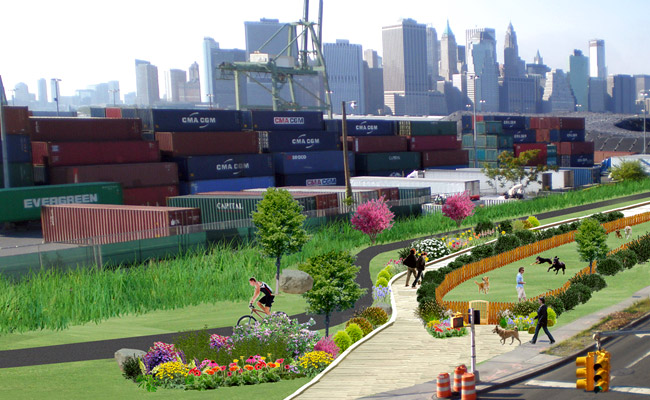
Article by Frederick Fooy
A sculpture garden, bike paths and bike rentals, concessions, green grass and colorful plantings, benches for reflecting on the Manhattan skyline, bocce courts and a farmer’s market—all kinds of nice ideas are getting floated in meetings concerning a new park for the Columbia Street waterfront, at the end of Degraw Street.
One message has been clear in recent meetings regarding the park: Residents are tired of playgrounds and parks for children. Neighborhood residents want a park that’s geared toward adults, including adults fleeing children or wishing to sit quietly.
And in this, it looks like the adults might get their way.
The Brooklyn Greenway Initiative, headquartered on Columbia Street, has worked feverishly for years to raise money and awareness for building bike paths and green space along the Brooklyn waterfront, in a 14-mile stretch from Greenpoint through Williamsburg and Red Hook to Sunset Park. It appears some of the planning is coming closer to reality.
The city Parks Department has expressed interest in acquiring a 1.7-mile plot at Columbia and Degraw, and transforming the drab piece of land into a so-called “open space node.†Funding for construction and maintenance must be secured, and planning is underway. The as-of-yet unnamed park will enhance the Brooklyn Greenway that is planned to run between Newtown Creek in the north and the Shore Parkway Greenway, 14 miles south.
Recently a community workshop was co-hosted by the Brooklyn Greenway Initiative (BGI) and the Regional Planning Authority (RPA), with Milton Puryear from BGI and Paul Winters from RPA introducing the issues at hand to approximately 70 neighbors from around Columbia Street. Brooklyn Parks Department Chief of Staff Marty Maher, representatives of local elected officials and the Department of Transportation were also in attendance.
As outlined by BGI and RPA, alternatives for the future park may include an open green space with gardens, a park with amenities such as a bike-rental-and-repair shop, a concession stand with a seating area, or a sculpture garden with a playground.
Though a significant number of the workshop participants were parents, there was widespread consensus that the recreational needs of children are catered for in the area, with both Mother Cabrini and Van Vorhees Park, not to mention Pier 6 playground, providing amenities for the ever-increasing number of young ones in the community.
Instead of monkey bars, the adults at the meeting called for “gravel games,†such as petanque and bocce, as well as chess tables and seating.
Another common theme was the need for natural topography to break up the homogenous expanse that we see today, by building something that will either hide or highlight the container port that lies beyond the proposed park.
As for the generation of revenue, there were suggestions of holding a farmer’s market during the weekends, while providing a hookup for a mobile vendor to provide food for walking, biking or driving commuters during weekdays. Contextual advertising for local businesses along the Greenway north of the proposed park could provide additional revenue.
History
The corner of Columbia and DeGraw streets, on the Brooklyn waterfront, has been unremarkable and bleak for decades, being sandwiched in between the containers that decorate the docks of American Stevedoring and the traffic on Columbia Street. The 600 by 80 foot area used to be full of housing, and almost forgotten street names like Irving and Sedgewick Streets can still be found on old city maps and as forlorn street signs still adorning the east side of Columbia Street.
The area was condemned after buildings collapsed as the water table was unintentionally lowered during sewer and water line reconstruction in the 1970s. Approximately 30 buildings were demolished, and the parcel of land on DeGraw and Columbia was designated as a diverter lane for truck traffic.
The 1.7 acre plot was later surrounded by a rickety fence and eventually used for parking. Last year, the fence came down, a new one went up, and the Department of Transportation together with the Department of Environmental Protection filled this spot with equipment to be used for the Gowanus Flushing Tunnel and the reconstruction of Van Brundt Street.
There are, of course, many issues that need to be resolved at the site before park construction can start. This includes testing the quite compacted soil on the lot for possible contamination, and since the Columbia Waterfront housed considerable manufacturing during the late 19th century and half of the 20th, this may be a problem. The traffic on Columbia Street may also be a source for concern, since today’s traffic lighting solution forces pedestrian to dash over Columbia Street while avoiding fast-moving vehicles that turn right on DeGraw Street or try to speed south down Columbia Street.
The frustrating experience of pedestrians trying to access Pier 6 last summer should not be repeated on Columbia or DeGraw Street. Finally, the plots beyond the proposed park are leased from American Stevedoring from the Port Authority, and this lease expires in just about eight years. Little is known of what eventually might become of the piers currently used by American Stevedoring, but the future of these piers will obviously affect a park on Columbia Street.
The workshop discussed names for a new park. Many participants wanted name that would connect to the rich history of the area, and suggestions included “The Columbia Diversion,†“The Irving” or “Sedgewick” park, as well as “The Old Clock Park.â€
To learn more about the Brooklyn Greenway Initiative, to attend meetings or donate money, visit http://www.brooklyngreenway.org/
